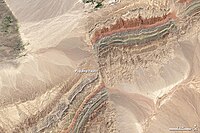
Photo from wikipedia
In November 2017, anMw 5.4 earthquake with a shallow (∼4 km) hypocenter occurred in the Pohang area, one of the most developing industrial cities in South Korea. This shock resulted… Click to show full abstract
In November 2017, anMw 5.4 earthquake with a shallow (∼4 km) hypocenter occurred in the Pohang area, one of the most developing industrial cities in South Korea. This shock resulted in the costliest earthquake damages in modern Korean history. Immediately after the event, it was not easy to recognize the source fault due to the lack of clear coseismic surface ruptures but also the absence of previously mapped active faults around the epicenter. Based on satelliteand unmanned aerial vehicle (UAV)-derived images, with ground resolution higher than 0.5 m, and field observations, we investigate surface deformation such as sand blows and ground failures associated with the Pohang earthquake as well as bedrock fault exposures in the epicentral area. To better constrain the source fault and deformation mechanism, we combine both moment tensors with aftershock relocations and surface displacements estimated by Interferometric Synthetic Aperture Radar (InSAR). Our results indicate that (1) various types and distributions of secondary ground deformation were controlled by blind oblique-slip rupture; characterized by right-lateral and reverse-slip components, on a reactivated pre-existing segmented normal-fault system, and (2) local ground conditions could trigger or amplify ground deformations and their related earthquake damage. Our study highlights the importance of mapping the extent of coseismic deformation as well as the trace of active faults on improving seismic hazard assessments in the Korean Peninsula.
Journal Title: Bulletin of the Seismological Society of America
Year Published: 2019
Link to full text (if available)
Share on Social Media: Sign Up to like & get
recommendations!